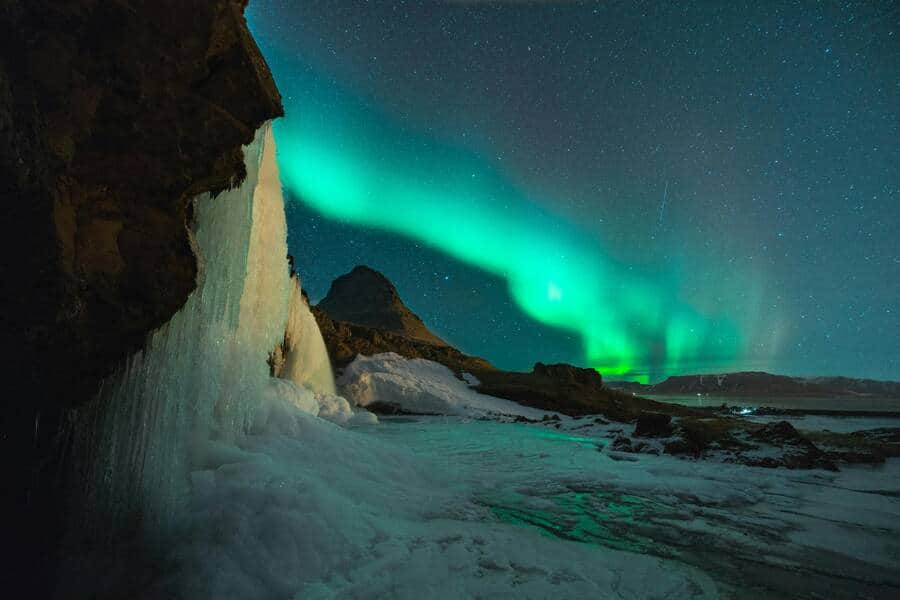Experiencing the Northern Lights, or Aurora Borealis, is a dream for many travellers, and Iceland is one of the best places in the world to witness this stunning natural phenomenon. This guide explores the best spots across Iceland to view the Northern Lights, along with tips on when to visit and how to maximise your chances of a sighting.
Understanding the Aurora
The Northern Lights are caused by particles from the sun interacting with the upper atmosphere near the North Pole, creating a dazzling display of colourful lights in the night sky. The lights are best viewed in locations with dark skies away from city light pollution, during clear nights between September and April when solar activity is at its peak.
Best Time of the Year to Visit
The ideal months for Northern Lights viewing in Iceland are from late September to early April. During these months, the nights are darkest, providing a perfect canvas for the lights. The aurora can be seen as early as dusk and as late as dawn, with peak viewing typically around midnight.
Best Spots in Iceland to View the Northern Lights
While the Northern Lights can be visible throughout Iceland, certain locations offer optimal conditions for a clearer and more dramatic experience:
- Þingvellir National Park: Located about an hour’s drive from Reykjavik, this UNESCO World Heritage Site offers a stunning natural backdrop and is far enough from city lights to provide a clear view of the aurora.
- Jökulsárlón Glacier Lagoon: The icebergs and the reflective waters of the lagoon can create spectacular conditions for viewing and photographing the Northern Lights.
- Vik: The beaches near Vik provide a dark, expansive view over the ocean, enhancing the visibility of the aurora with minimal light pollution.
- Snaefellsnes Peninsula: Known for its dramatic landscapes and relatively remote location, the peninsula is ideal for aurora viewing, offering diverse scenery as a backdrop.
- Kirkjufell: This mountain near Grundarfjörður, especially with its waterfalls, is one of the most picturesque places to capture the Northern Lights in Iceland.
Guided Tours vs. Independent Viewing
Whether to join a guided tour or seek out the lights independently depends on your preference and comfort in navigating rural Iceland in winter:
- Guided Tours: Offer the expertise of local guides who know the best viewing spots and conditions; they can also provide additional equipment like thermal suits and tripods.
- Independent Viewing: Offers more flexibility and the possibility of a private experience. A 4×4 vehicle is recommended to navigate icy roads safely.
Photography Tips
Photographing the Northern Lights can be challenging but rewarding. Here are some tips to capture the aurora:
- Use a DSLR camera capable of manual settings.
- Wide-angle lens: Ideal for capturing the vastness of the sky.
- Tripod: Essential for stability during long exposures.
- Use long exposures: Typically, settings of ISO 1600, f/2.8, and 15-30 seconds exposure are a good start.
- Experiment: Conditions can change rapidly, so continuously adjust your settings and composition.
Preparation for Aurora Chasing
Chasing the Northern Lights requires some preparation, especially regarding clothing and equipment:
- Dress warmly: Wear multiple layers, a windproof jacket, thermal leggings, hats, gloves, and waterproof boots.
- Bring refreshments: Hot drinks and snacks can make a night waiting for the lights more comfortable.
- Plan for weather conditions: The weather in Iceland can be unpredictable; check forecasts and road conditions.
Accommodations
When planning your Northern Lights trip, consider staying in accommodations that offer good access to dark skies:
- Hotels with Aurora Wake-Up Calls: Many hotels in prime viewing areas offer alerts to wake you if the Northern Lights appear.
- Remote Cabins and Guesthouses: Locations away from town centres are ideal for reducing light pollution.
Cultural Significance of the Aurora
In Icelandic culture, the Northern Lights have various folklore associated with them, often seen as omens or spirits of the ancestors. Engaging with local guides can provide a deeper understanding of these cultural stories and enhance your viewing experience.
Best Transport Options
Travelling to and around Iceland’s best Northern Lights spots can be achieved in several ways:
- Rental Cars: Ideal for flexibility; 4×4 vehicles recommended for winter conditions.
- Organized Tours: Many companies offer Northern Lights tours that include transportation and guide services.
Chasing the Northern Lights in Iceland is an adventure of a lifetime. With the right preparation, timing, and location, you can experience one of nature’s most dazzling displays set against the unique backdrop of Iceland’s landscapes. Whether you capture it on camera or just take in the sight, the aurora borealis in Iceland promises to be an unforgettable experience.


